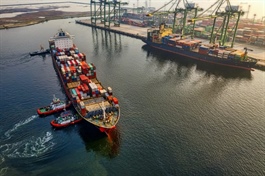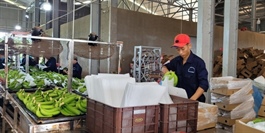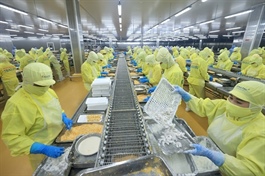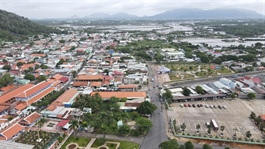Green finance framework vital for reshaping industrial future
Green finance framework vital for reshaping industrial future
Vietnam is in critical need for a clearer framework for green finance to develop its carbon trading and renewables ecosystem and reshape its industrial future.
As Vietnam enters the era of green growth and strives to reach net-zero emissions by 2050, the discussion around green finance has become an urgent necessity for the country’s sustainable development.
At last week’s Vietnam Business Forum (VBF), Van Ly, co-founder and CEO of Raise Partners and co-chair of the VBF’s Agriculture and Environment Working Group, said Vietnam has laid the “skeletal structure” for a compliance carbon market, identifying more than 2,000 enterprises required to conduct mandatory greenhouse gas (GHG) inventories.
“Government-led training programmes and international cooperation efforts since 2023 have helped large emitters prepare for emission reporting, reduction planning, and the upcoming pilot phase of the carbon market in 2025-2026,” she said.
However, Ly also pointed out that the implementation gap remains significant. The roadmap for greenhouse gas reduction is yet to be clearly defined; definitions and procedures for registering or trading carbon credits are still inconsistent; and national standards are being drafted.
“Without detailed guidance, companies will find it difficult to plan emissions targets, allocate quotas, and execute long-term green projects,” she warned.
Over the past three years, Vietnam has made notable progress in creating a regulatory framework for green growth. The issuance of decrees on GHG mitigation and carbon markets, as well as approving the national carbon market development scheme, form a crucial policy backbone for green finance to function effectively.
The carbon market is viewed as one of the most powerful economic tools to help businesses transition towards low-carbon operations. In Vietnam, its potential is enormous, not only due to domestic emission volumes but also thanks to growing international partnerships.
Experts from the VBF have proposed four priority actions: to recognise carbon as a tradable asset, develop high-quality carbon credit projects aligned with international standards; increase market liquidity through international links, and prepare for market maturity, when emission allowances will be auctioned publicly and the market will operate nationwide by 2029.
“Building a robust carbon market helps Vietnam cut emissions and creates new financial flows, attracting both domestic and foreign investment into green projects,” Ly said.
Ko Tae Yeon, CEO of Heesung Electronics Vietnam and chairman of ther Korean Chamber of Commerce and Industry, noted that environmental, social, and governance (ESG) is now a prerequisite for survival in global supply chains.
He believes that combining South Korea’s advanced clean technologies with Vietnam’s dynamic manufacturing base could transform the two countries into a leading eco-friendly production hub in Asia. But to achieve that, Vietnam needs stronger incentives and support mechanisms for ESG-performing enterprises, along with better access to green finance.
Ko also highlighted human capital development as a decisive factor. “Vietnam and South Korea can jointly expand vocational training and school-enterprise partnerships to nurture a workforce capable of leading the era of green and digital economies,” he said.
Denzel Eades, chairman of the British Chamber of Commerce in Vietnam (BritCham), said that Vietnam will require over $136 billion for power and grid infrastructure between now and 2030, far beyond what public budgets can provide.
“To achieve net-zero goals, Vietnam must mobilise private investment through green loans, sustainable bonds, and blended finance mechanisms,” he said.
One promising avenue is the Just Energy Transition Partnership, which opens the door to large-scale funding for clean energy. However, Eades identified a lack of a comprehensive national green finance taxonomy, leaving banks uncertain about eligible projects; limited ESG disclosure requirements and absence of independent verification systems; and insufficient credit guarantees and green lending incentives, which still make financing risky.
BritCham therefore recommends that the government issues a clear green finance classification system, establishes credit guarantee or risk-sharing funds, and expands incentives for circular economy projects and green credit schemes.
Bruno Jaspaert, chairman of the European Chamber of Commerce in Vietnam (EuroCham), stressed that the will to decarbonise exists, but financial mechanisms are still missing. He suggested developing tools such as green trade credit insurance to make sustainability financially accessible. “Sustainable trade finance should be done by encouraging banks to develop innovative products such as green loans, ESG-linked credit, and trade insurance,” Jaspaert suggested.
Adaptation finance will develop a national framework for climate adaptation finance, participate more actively in global climate finance mechanisms, and consider establishing a national green investment bank to mobilise funds for climate-resilient projects in agriculture, coastal infrastructure, and cities, he added.
Across all business associations, there is a shared consensus: effective public-private dialogue is essential to make green finance a reality. Such collaboration must go beyond consultation and be translated into tangible actions, building transparent emission databases, standardised ESG reporting systems, and targeted training programmes for small and medium-sized enterprises.
“This is not just a story for big corporations,” Jaspaert noted. “Smaller businesses must also have access to green funding and ESG capacity-building if they are to remain part of global supply chains.”
Vietnam is increasingly recognised as a regional frontrunner in green growth, but sustaining that position requires a coherent national strategy, combining legal frameworks, financial incentives, and strong implementation capacity.
Yeon of Heesung Electronics Vietnam said, “If the government and businesses act faster and stronger, with clear incentives and equitable access to green finance, Vietnam can absolutely become Asia’s green manufacturing hub in the near future.”
- 10:17 17/11/2025






















